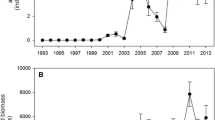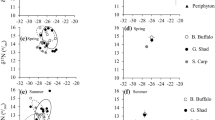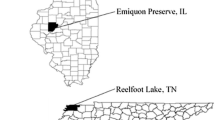Abstract
Community structure and dynamics in aquatic ecosystems are influenced by a variety of abiotic and biotic factors including productivity, species composition, and temperature. These factors may also affect local-scale community resilience to nonnative species invasions. We used habitat characteristics, zooplankton concentrations, fish abundances, and species composition and richness data collected by two fish population monitoring programs to define relationships that influence stress and nutrition in invasive silver carp (Hypophthalmichthys molitrix). We collected blood samples and quantified nutritional (alkaline phosphatase, cholesterol, protein, and triglycerides) and stress metrics (cortisol and glucose) from individuals across three distinct time periods. Nutritional patterns in silver carp were explained by temperature and food resources, indicating elevated feeding in warmer months. Patterns in blood-based stress parameters were most strongly driven by environmental characteristics, elevating with high water temperatures and increased turbidity. Nutrient levels and community richness parameters did not influence the stress or condition of silver carp, likely due to the absence of limiting resources or competition for this species. Together, our results provide insights into the factors that may influence the spread and distribution of silver carp, as well as the characteristics of habitats that could be vulnerable to future silver carp invasion.
Similar content being viewed by others
References
Akar, A. M., 2011. Effects of stress on Spawners reproductive performance in female grass carp (Ctenopharyngodon idella). Arabian Aquaculture Society 6: 171–180.
APHA, 1992. Standard Methods for the Examination of Water and Wastewater. American Public Health Association, Washington DC.
Barton, B. A., 2002. Stress in fishes: a diversity of responses with particular reference to changes in circulating corticosteroids. Integrative and Comparative Biology 42: 517–525. http://www.ncbi.nlm.nih.gov/pubmed/21708747.
Barton, B. A., J. D. Morgan & M. M. Vijayan, 2002. Physiological and Condition-Related Indicators of Environmentals Stress in Fish. American Fisheries Society, Bethesda, MD: 111–148.
Becker, G. C., 1983. Fishes of Wisconsin. University of Wisconsin Press, Madison, WI.
Buck, D. H., R. J. Baur & C. R. Rose, 1978. Utilization of swine manure in a polyculture of Asian and North American fishes. Transactions of the American Fisheries Society 107: 216–222.
Burel, C., J. Person-Le Ruyet, F. Gaumet, A. Le Roux, A. Severe & G. Boeuf, 1996. Effects of temperature on growth and metabolism in juvenile turbot. Journal of Fish Biology 49: 678–692.
Carpenter, S. R., S. W. Chisholm, C. J. Krebs, D. W. Schindler & R. F. Wright, 1995. Ecosystem experiments. Science 269: 324–327.
Chick, J. H., A. P. Levchuk, K. A. Medley & J. H. Havel, 2010. Underestimation of rotifer abundance a much greater problem than previously appreciated. Limnology and Oceanography: Methods 8: 79–87.
Congleton, J. L. & T. Wagner, 2006. Blood-chemistry indicators of nutritional status in juvenile salmonids. Journal of Fish Biology 69: 473–490.
Cooke, S. L., W. R. Hill & K. P. Meyer, 2009. Feeding at different plankton densities alters invasive bighead carp (Hypophthalmichthys nobilis) growth and zooplankton species composition. Hydrobiologia 625: 185–193.
De-Shang, L. & D. Shuang-Lin, 1996. The structure and function of the filtering apparatus of silver carp and bighead carp. Acta Zoologica Sinica 42: 10–14.
Dong, S. & D. Li, 1994. Comparative studies on the feeding selectivity of silver carp Hypophthalmichthys molitrix and bighead carp Aristichthys nobilis. Journal of Fish Biology 44: 621–626.
Donner, S., 2003. The impact of cropland cover on river nutrient levels in the Mississippi River Basin. Global Ecology & Biogeography 12: 341–355.
Duffy, J. E., 2009. Why biodiversity is important to the functioning of real-world ecosystems. Frontiers in Ecology and the Environment 7: 437–444.
Encina, L. & C. Granado-Lorencio, 1997. Seasonal variations in the physiological status and energy content of somatic and reproductive tissues of chub. Journal of Fish Biology 50: 511–522.
Farbridge, K. J. & J. F. Leatherland, 1992. Temporal changes in plasma thyroid hormone, growth hormone and free fatty acid concentrations, and hepatic 5′-monodeiodinase activity, lipid and protein content during chronic fasting and re-fasting in rainbow trout (Oncorhynchus mykiss). Fish Physiology and Biochemistry 10: 245–257.
Gido, K. B. & J. H. Brown, 1999. Invasion of North American drainages by alien fish species. Freshwater Biology 42: 387–399.
Gingerich, A. J., D. P. Philipp & C. D. Suski, 2010. Effects of nutritional status on metabolic rate, exercise and recovery in a freshwater fish. Journal of Comparative Physiology B, Biochemical, Systemic, and Environmental Physiology 180: 371–384. http://www.ncbi.nlm.nih.gov/pubmed/19936760.
Green, B. W. & R. O. Smitherman, 1984. Relative growth, survival and harvestability of bighead carp, silver carp, and their reciprocal hybrids. Aquaculture 37: 87–95.
Guerreiro, I., H. Peres, M. Castro-Cunha & A. Oliva-Teles, 2012. Effect of temperature and dietary protein/lipid ratio on growth performance and nutrient utilization of juvenile Senegalese sole (Solea senegalensis). Aquaculture Nutrition 18: 98–106.
Gutreuter, S., R. Burkhardt & K. Lubinski, 1995. Long Term Resource Monitoring Program procedures: Fish Monitoring. National Biological Service. Onalaska, WI: 95-P002-1.
Haddy, J. A. & N. W. Pankhurst, 1999. Stress-induced changes in concentrations of plasma sex steroids in black bream. Journal of Fish Biology 55: 1304–1316.
Hasler, C. T., M. R. Donaldson, R. P. B. Sunder, E. Guimond, D. A. Patterson, B. Mossop, S. G. Hinch & S. J. Cooke, 2011. Osmoregulatory, metabolic, and nutritional condition of summer-run male Chinook salmon in relation to their fate and migratory behavior in a regulated river. Endangered Species Research 14: 79–89. http://www.int-res.com/abstracts/esr/v14/n1/p79-89/.
Hegyi, G. & L. Z. Garamszegi, 2011. Using information theory as a substitute for stepwise regression in ecology and behavior. Behavior Ecology and Sociobiology 65: 69–76. http://lira.pro.br/wordpress/wp-content/uploads/2012/05/hegyi-e-garamszegi-2011.pdf.
Herborg, L.-M., N. E. Mandrak, B. C. Cudmore & H. J. Maclsaac, 2007. Comparative distribution and invasion risk of snakehead (Channidae) and Asian carp (Cyprinidae) species in North America. Canadian Journal of Fisheries and Aquatic Sciences 64: 1723–1735. http://web2.uwindsor.ca/courses/biology/macisaac/pages/mattcjfas.pdf.
Ickes, B. S. & R. W. Burkhardt, 2002. Evaluation and proposed refinement of the sampling design for the Long Term Resource Monitoring Program’s fish component. La Crosse, Wisconsin: 1–38.
Irons, K. S., G. G. Sass, M. A. McClelland & J. D. Stafford, 2007. Reduced condition factor of two native fish species coincident with invasion of non-native Asian carps in the Illinois River, U.S.A. Is this evidence for competition and reduced fitness? Journal of Fish Biology 71: 258–273.
Jeppesen, E., J. P. Jensen, M. Søndergaard, T. Lauridsen & F. Landkildehus, 2000. Trophic structure, species richness and biodiversity in Danish lakes: changes along a phosphorus gradient. Freshwater Biology 45: 201–218.
Junk, W., P. Bayley & R. Sparks, 1989. The flood pulse concept in river-floodplain systems. In Dodge, D. P. (ed.), Proceedings of the International Large River Symposium, vol. 106. Canadian Special Publication of Fisheries and Aquatic Sciences, Ottawa: 110–127.
Karr, J. R., L. A. Toth & D. R. Dudley, 1985. Fish communities of Midwestern rivers: a history of degradation. BioScience 35: 90–95.
Kassahn, K. S., R. H. Crozier, H. O. Pörtner & M. J. Caley, 2009. Animal performance and stress: responses and tolerance limits at different levels of biological organisation. Biological Reviews of the Cambridge Philosophical Society 84: 277–292. http://www.ncbi.nlm.nih.gov/pubmed/19344429.
Kitchell, J. F., D. J. Stewart & D. Weininger, 1977. Applications of a bioenergetics model to yellow perch (Perca flavescens) and walleye (Stizostedion vitreum vitreum). Canadian Journal of Fisheries and Aquatic Sciences 34: 1910–1921.
Koel, T. M. & R. E. Sparks, 2002. Historical patterns of river stage and fish communities as criteria for operations of dams on the Illinois River. River Research and Applications 18: 3–19.
Kolar, C. S., D. C. Chapman, W. R. Courtenay Jr, C. M. Housel, J. D. Williams & D. P. Jennings, 2007. Bigheaded Carps: A Biological Synopsis and Environmental Risk Assessment. American Fisheries Society, Bethesda, MD: 1–204.
Liss, S. A., G. G. Sass & C. D. Suski, 2013. Spatial and temporal influences on the physiological condition of invasive silver carp. Conservation Physiology 1. http://conphys.oxfordjournals.org/content/1/1/cot017.abstract.
Lowe, W. H., G. E. Likens & M. E. Power, 2006. Linking scales in stream ecology. BioScience 56: 591–597. http://www.jstor.org/stable/4099753.
McClelland, M. A., G. G. Sass, T. R. Cook, K. S. Irons, N. Nerissa, T. M. O’Hara & C. S. Smith, 2012. The long-term Illinois River fish population monitoring program. Fisheries 37: 340–350.
McLeese, J. M., J. Johnsson, F. M. Huntley, W. C. Clarke & M. Weisbart, 1994. Seasonal changes in osmoregulation, cortisol, and cortisol receptor activity in the gills of parr/smolt of steelhead trout and steelhead-rainbow trout hybrids, Oncorhynchus mykiss. General and Comparative Endocrinology 93: 103–113.
Menge, B. A. & J. P. Sutherland, 1987. Community regulation: variation in disturbance, competition, and predation in relation to environmental stress and recruitment. The American Naturalist 130: 730–757.
Mommsen, T. P., M. M. Vijayan & T. W. Moon, 1999. Cortisol in teleosts: dynamics, mechanisms of action, and metabolic regulation. Reviews in Fish Biology and Fisheries 9: 211–268.
Omarov, M. O., 1970. The daily food consumption of the silver carp Hypophthalmichthys molitrix (Val.). Journal of Ichthyology 10: 425–426.
Pegg, M. A. & M. A. McClelland, 2004. Spatial and temporal patterns in fish communities along the Illinois River. Ecology of Freshwater Fish 13: 125–135.
Pflieger, W. L., 1975. The Fishes of Missouri. Missouri Department of Conservation, Jefferson City, MI.
Poff, N. L. & J. D. Allan, 1995. Functional organization of stream fish assemblages in relation to hydrological variability. Ecology 76: 606–627.
Pottinger, T. G. & T. R. Carrick, 2000. Contrasting seasonal modulation of the stress response in male and female rainbow trout. Journal of Fish Biology 56: 667–675.
Ramsay, J. M., G. W. Feist, Z. M. Varga, M. Westerfield, M. L. Kent & C. B. Schreck, 2006. Whole-body cortisol is an indicator of crowding stress in adult zebrafish, Danio rerio. Aquaculture 258: 565–574. http://linkinghub.elsevier.com/retrieve/pii/S004484860600295X.
Redding, J. M., C. B. Schreck & F. H. Everest, 1987. Physiological effects on Coho salmon and steelhead of exposure to suspended solids. Transactions of the American Fisheries Society 116: 737–744.
Ricciardi, A. & H. J. MacIsaac, 2011. Impacts of Biological Invasions on Freshwater Ecosystems. Blackwell, Oxford: 211–224. http://redpath-staff.mcgill.ca/ricciardi/Ricciardi_Elton_C16.pdf.
Ricklefs, R. E. & M. Wikelski, 2002. The physiology/life-history nexus. Trends in Ecology & Evolution 17: 462–468.
Romero, L. M. & J. M. Reed, 2005. Collecting baseline corticosterone samples in the field: is under 3 min good enough? Comparative Biochemistry and Physiology, Part A, Molecular & Integrative Physiology 140: 73–79. http://www.ncbi.nlm.nih.gov/pubmed/15664315.
Sampson, S. J., J. H. Chick & M. A. Pegg, 2009. Diet overlap among two Asian carp and three native fishes in backwater lakes on the Illinois and Mississippi rivers. Biological Invasions 11: 483–496.
Sandnes, K., O. Lie & R. Waagbo, 1988. Normal ranges of some blood chemistry parameters in adult farmed Atlantic salmon, Salmo salar. Journal of Fish Biology 32: 129–136.
Sass, G. G., T. R. Cook, K. S. Irons, M. A. McClelland, N. N. Michaels, T. M. O’Hara & M. R. Stroub, 2010. A mark-recapture population estimate for invasive silver carp (Hypophthalmichthys molitrix) in the La Grange Reach, Illinois River. Biological Invasions 12: 433–436.
Schindler, D. W., 1974. Eutrophication and recovery in experimental lakes: implications for lake management. Science 184: 897–899.
Schindler, D. W., 1998. Replication versus realism: the need for ecosystem-scale experiments. Ecosystems 1: 323–334.
Schlosser, I. J., 1990. Environmental variation, life history attributes, and community structure in stream fishes: implications for environmental management and assessment. Environmental Management 14: 621–628.
Schlosser, I. J., 1991. Stream fish ecology: a landscape perspective. BioScience 41: 704–712.
Schreck, C. B., 2010. Stress and Fish Reproduction: The Roles of Allostasis and Hormesis. General and Comparative Endocrinology, vol. 165. Elsevier, Amsterdam: 549–556. http://www.ncbi.nlm.nih.gov/pubmed/19596332.
Shea, K. & P. Chesson, 2002. Community ecology theory as a framework for biological invasions. Trends in Ecology & Evolution 17: 170–176.
Shuang-lin, D. & L. De-shang, 1994. Comparative studies on the feeding capacity of silver carp and bighead carp. Chinese Journal of Oceanology and Limnology 12: 185–192.
Sink, T. D., R. T. Lochmann & K. A. Fecteau, 2008. Validation, use, and disadvantages of enzyme-linked immunosorbent assay kits for detection of cortisol in channel catfish, largemouth bass, red pacu, and golden shiners. Fish Physiology and Biochemistry 34: 95–101. http://www.ncbi.nlm.nih.gov/pubmed/18649027.
Soballe, D. M. & J. R. Fischer, 2004. Long Term Resource Monitoring Program Procedures: Water Quality Monitoring. La Crosse, Wisconsin.
Symonds, M. R. E. & A. Moussalli, 2011. A brief guide to model selection, multimodel inference and model averaging in behavioural ecology using Akaike’s information criterion. Behavior Ecology and Sociobiology 65: 13–21. http://www.springerlink.com/content/f6827222617w8r36/fulltext.pdf?MUD=MP.
Tilman, D., 2004. Niche tradeoffs, neutrality, and community structure: a stochastic theory of resource competition, invasion, and community assembly. Proceedings of the National Academy of Sciences of the United States of America 101: 10854–10861. http://www.pubmedcentral.nih.gov/articlerender.fcgi?artid=503710&tool=pmcentrez&rendertype=abstract.
Tilman, D., J. Knops, D. Wedin, P. Reich, M. Ritchie & E. Siemann, 1997. The influence of functional diversity and composition on ecosystem processes. Science 277: 1300–1302.
Tonn, W. M., 1990. Climate change and fish communities: a conceptual framework. Transactions of the American Fisheries Society 119: 337–352.
Tonn, W. M. & J. J. Magnuson, 1982. Patterns in the species composition and richness of fish assemblages in Northern Wisconsin lakes. Ecology 63: 1149–1166.
Tyszko, S. M., N. N. Michaels, B. J. Lubinski, T. W. Edison, J. E. Epifanio, J. H. Chick, Y. Cao & G. G. Sass, 2012. The long-term Illinois, Mississippi, Ohio, and Wabash Rivers fish population monitoring program 2011. Annual Report to the Illinois Department of Natural Resources, Havana: 1–121.
Vannote, R., G. Minshall, K. Cummins, J. Sedell & C. Cushing, 1980. The River Continuum Concept. Canadian Journal of Fisheries and Aquatic Sciences 37: 130–137.
Von Oertzen, J.-A., 1985. Resistance and capacity adaptation of juvenile silver carp, Hypophthalmichthys molitrix (Val.) to temperature and salinity. Aquaculture 44: 321–332.
Wagner, T. & J. L. Congleton, 2004. Blood chemistry correlates of nutritional condition, tissue damage, and stress in migrating juvenile Chinook salmon (Oncorhynchus tshawytscha). Canadian Journal of Fisheries and Aquatic Sciences 61: 1066–1074.
Wagner, T., M. L. Jones, M. P. Ebener, M. T. Arts, T. O. Brenden, D. C. Honeyfield, G. M. Wright & M. Faisal, 2010. Spatial and temporal dynamics of lake whitefish (Coregonus clupeaformis) health indicators: linking individual-based indicators to a management-relevant endpoint. Journal of Great Lakes Research Elsevier B.V. 36: 121–134. http://linkinghub.elsevier.com/retrieve/pii/S0380133009001452.
Wahl, D. H., J. Goodrich, M. A. Nannini, J. M. Dettmers & D. A. Soluk, 2008. Exploring riverine zooplankton in three habitats of the Illinois River ecosystem: where do they come from? Limnology and Oceanography 53: 2583–2593.
Wells, R. M. G. & N. W. Pankhurst, 1999. Blood glucose and lactate, and plasma protein as stress indicators in fish. Journal of the World Aquaculture Society 30: 276–284.
Wingfield, J. C., 2013. Ecological processes and the ecology of stress: the impacts of abiotic environmental factors. Functional Ecology 27: 37–44.
Wootton, R. J., 1998. Ecology of Teleost Fishes. Kluwer, Norwell, MA: 386 pp. http://books.google.com/books?hl=en&lr=&id=uYOOfHPJSgEC&pgis=1.
Acknowledgements
This research was supported by the Illinois Department of Natural Resources and the United States Fish and Wildlife Service Federal Aid in Sportfish Restoration Project [F-101-R]. This research was also supported by the University of Illinois Graduate College: College of Agricultural, Consumer and Environmental Sciences: and Department of Natural Resources and Environmental Sciences. The authors thank the staff of the Illinois Natural History Survey’s Illinois River Biological Station, The Long-Term Illinois, Mississippi, Ohio, and Wabash Rivers Fish Population Monitoring Program, and the Upper Midwest Environmental Sciences Center.
Author information
Authors and Affiliations
Corresponding author
Additional information
Handling editor: M. Power
Rights and permissions
About this article
Cite this article
Liss, S.A., Sass, G.G. & Suski, C.D. Influence of local-scale abiotic and biotic factors on stress and nutrition in invasive silver carp. Hydrobiologia 736, 1–15 (2014). https://doi.org/10.1007/s10750-014-1880-y
Received:
Revised:
Accepted:
Published:
Issue Date:
DOI: https://doi.org/10.1007/s10750-014-1880-y




